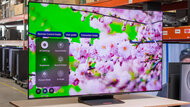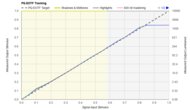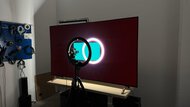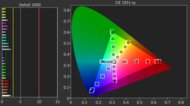OLED TVs have become quite popular over the last few years, and they've dropped in price significantly. What truly separates OLED TVs from the pack is their ability to display perfect blacks without the blooming seen on Mini LED TVs with local dimming, which we confirm by testing the contrast ratio. We also take videos of each TV's blooming performance so you can see how OLEDs compare to other TVs that suffer from noticeable blooming. When OLEDs were first introduced, they didn't perform very well in bright rooms due to their relatively low brightness. However, in the past few years, our brightness and reflection handling tests show that most modern OLEDs perform well in rooms with some lights on, too. OLEDs typically excel in many other areas as well, which is confirmed by more than 350 rigorous tests we perform on TVs.
Due to their popularity, there are many OLEDs on the market, so you might be overwhelmed by the number of options if you find yourself searching for the best OLED model. We've bought and tested over 60 OLED models in our lab, which has helped us evaluate how emerging technologies like QD-OLED and Micro Lens Array (MLA) enhance brightness and color vibrancy. Check out our What Is OLED article to learn more about OLED technology.
Below are our recommendations for the best OLED televisions you can buy in the US. You can also explore our picks for the best TVs, the best gaming TVs, and the best TV brands. Feel free to vote on which models you want us to buy and test. For insight into the current TV landscape, visit our 2025 TV lineup page.
Quick Look




We buy and test dozens of TVs yearly, taking an objective, data-driven approach to deliver results you can trust. Our testing process is complex, with hundreds of individual tests that take over a week to complete. Most of our tests are done with specially designed test patterns that mimic real content, but we also use the same sources you have at home to ensure our results match the real-world experience. We use two main tools for our testing: a Colorimetry Research CR-100 colorimeter and a CR-250 spectroradiometer.
-
Best OLED TV
 Mixed Usage8.9Home Theater9.0Bright Room8.8Sports8.8Gaming9.3Game Mode Responsiveness9.4Brightness8.7Black Level10Color9.1Processing (In Development)8.3HDR Color Volume9.2HDR Brightness8.7See all our test resultsSDR Brightness8.6
Mixed Usage8.9Home Theater9.0Bright Room8.8Sports8.8Gaming9.3Game Mode Responsiveness9.4Brightness8.7Black Level10Color9.1Processing (In Development)8.3HDR Color Volume9.2HDR Brightness8.7See all our test resultsSDR Brightness8.6The Samsung S95F OLED is the best OLED TV we've tested. It truly does it all, with an outstanding combination of top-tier image quality, gaming performance, and versatility. Like any OLED, it displays incredibly deep, inky blacks that are sure to impress. Since this model utilizes a QD-OLED panel, colors are vivid and exceptionally punchy in both SDR and HDR content. To top it off, highlights in HDR are very bright and nearly jump off the screen, so you get a top-tier HDR experience. Many OLEDs struggle with visibility in bright rooms, but not this one. It's a very bright TV in SDR and has a unique matte coating that essentially makes glare a non-issue, so reflections on the screen are a thing of the past. You also don't have to worry about the TV's image quality degrading when you or your friends are watching TV from an angle, making it a great option for wide seating arrangements. Adding to its versatility is the included external Slim One Connect Box, which provides you with an easy way to manage your cables.
If you're a gamer looking for a TV to pair with your console or PC, this is one of the best options on the market. It has four HDMI 2.1 ports capable of 4k @ 165Hz, and it supports FreeSync, G-SYNC, and HDMI Forum VRR, you get an almost tear-free experience no matter what setup you have. Like any OLED, it has nearly instantaneous response times, so fast motion is crystal clear. It also provides low input lag, especially at higher refresh rates, so gaming feels snappy. When you add in the TV's easy-to-use Tizen OS and solid image processing, you get an OLED TV that truly excels in almost any usage. It doesn't support the popular Dolby Vision format, but on a TV this good, Dolby Vision doesn't make a big difference at all, and it does support the similar HDR10+.
-
Best Upper Mid-Range OLED TV
 Mixed Usage8.6Home Theater8.8Bright Room7.6Sports8.1Gaming9.1Game Mode Responsiveness9.4Brightness8.0Black Level10Color8.8Processing (In Development)8.4HDR Color Volume9.1HDR Brightness8.3See all our test resultsSDR Brightness7.2
Mixed Usage8.6Home Theater8.8Bright Room7.6Sports8.1Gaming9.1Game Mode Responsiveness9.4Brightness8.0Black Level10Color8.8Processing (In Development)8.4HDR Color Volume9.1HDR Brightness8.3See all our test resultsSDR Brightness7.2If you're interested in a QD-OLED TV like the Samsung S95F OLED but find it out of your budget, the Samsung S90F OLED is a more affordable alternative that delivers nearly the same image quality. You get the same perfect black levels, colors are almost as vivid as they are on the more expensive model, and its great HDR brightness allows highlights to really stand out in HDR content. This makes it an excellent choice for home theater usage. It features a standard glossy screen finish and doesn't get quite as bright in SDR, which means it's not quite as effective in bright rooms as the S95F. That said, its reflection handling is still quite good, and it's bright enough in SDR for use in a moderately lit room without having to deal with visibility issues. It even has the same ultra-wide viewing angle as the S95F, so it's a solid option for large rooms with seating that's off to the sides of the screen.
It doesn't come with Samsung's Slim One Connect Box, but it does offer four HDMI 2.1 ports that support 4k @ 144Hz. Motion is nice and clear thanks to its super-fast pixel transitions, and its VRR support means you don't have to deal with screen tearing when your frame rate is inconsistent. No Samsung TV supports Dolby Vision, but like the S95F, you do get the very similar HDR10+. It runs the same Tizen OS, so you don't need an external streaming device to watch your favorite movies and shows. You also get the same level of image processing, which helps when you're watching low-resolution and low-quality content.
-
Best Mid-Range OLED TV
 Mixed Usage8.2Home Theater8.4Bright Room6.7Sports7.1Gaming8.5Game Mode Responsiveness9.0Brightness7.0Black Level10Color8.3Processing (In Development)8.3HDR Color Volume7.5HDR Brightness7.4See all our test resultsSDR Brightness6.0
Mixed Usage8.2Home Theater8.4Bright Room6.7Sports7.1Gaming8.5Game Mode Responsiveness9.0Brightness7.0Black Level10Color8.3Processing (In Development)8.3HDR Color Volume7.5HDR Brightness7.4See all our test resultsSDR Brightness6.0The LG B5 OLED is the closest thing to the best budget OLED TV on the market. It's not cheap by any means, but it's a great TV with high-end features and is an excellent entry point into the OLED market. The TV delivers the same inky blacks that OLEDs are known for, and it gets bright enough in HDR for highlights to stand out. It's just bright enough to handle glare in a moderately lit room, but reflections are visible in brighter rooms, especially ones with light sources directly facing the screen. Colors aren't as vivid as those on QD-OLED models, but they're still vibrant and impressively accurate right out of the box. Its viewing angle isn't quite as wide as the Samsung OLEDs, but it's still wide enough for large living rooms, as its image quality barely degrades when viewed at aggressive angles.
Although it doesn't support 144Hz or 165Hz, it still has four HDMI 2.1 ports capable of 4k @ 120Hz with VRR, so it's fully compatible with modern gaming consoles. Motion is incredibly clear thanks to its nearly instantaneous pixel transitions, and it also provides low input lag for a responsive feel. LG's webOS offers a huge catalogue of streaming apps, so finding content is a breeze. It even has solid image processing, which is great when the quality of your content is suboptimal. Unlike the Samsung models, it supports the popular Dolby Vision HDR format, but it doesn't support HDR10+.
Notable Mentions
-
LG G5 OLED:
The LG G5 OLED is one of the top OLED TVs on the market and competes with the Samsung S95F OLED. While the LG offers Dolby Vision and excellent colors, the Samsung still has a slight edge in overall vividness. The LG has some image quality quirks in some darker scenes, whereas the Samsung provides more consistent performance and handles bright rooms better, making it the better option for most people.
See our review -
Sony A95L OLED:
If you want a QD-OLED TV like the Samsung S95F OLED, but you'd rather have Dolby Vision support and some of the best image processing on the market, the Sony A95L is a solid option. Still, the Samsung offers superior bright room and gaming performance, making it the more well-rounded TV overall.
See our review -
LG C5 OLED:
The LG C5 OLED is a very good alternative to the Samsung S90F OLED if you really want a TV that supports Dolby Vision. The LG is even a bit better for bright rooms due to its higher peak SDR brightness. However, the Samsung gets brighter in its gaming mode and displays more vivid colors with less banding, making it the slightly better TV overall.
See our review -
Panasonic Z85A OLED:
The Panasonic Z85A OLED is a very capable OLED TV that competes with the Samsung S90F OLED. It has better upscaling and low-quality content smoothing, which is nice to have if you watch a lot of low-resolution and heavily compressed content. However, the Samsung is superior in pretty much every other way, making it the better choice for almost anyone.
See our review -
Samsung S85F OLED:
The Samsung S85F OLED is the cheapest QD-OLED you can get, but only if you're looking at the 55- or 65-inch models sold in the US. It mainly competes with the LG B5 OLED and has the edge in color performance. Still, the LG handles bright rooms better, offers more accurate colors, and uses the same panel type everywhere, which makes it the better option for most people.
See our review
Recent Updates
Nov 12, 2025:
Replaced the LG B4 OLED with the LG B5 OLED in the 'Best Mid-Range' category.
Jul 18, 2025:
We replaced the Samsung S90D OLED with the Samsung S95F OLED as our new top pick. We also replaced the LG C4 OLED with the Samsung S90F OLED in the 'Upper Mid-Range' category, and rewrote the text for the LG B4 OLED in the 'Best Budget' section for clarity. We also dropped the 'Best Value OLED' category because it was redundant.
Jan 08, 2025:
Updated some text throughout the article for clarity, and confirmed the accuracy of our current picks.
Oct 16, 2024: Replaced the Samsung S90C OLED, the LG C3 OLED, and the LG B3 OLED with their 2024 replacements. We also refreshed the Notable Mentions and added the recently reviewed Panasonic Z85A OLED and the Panasonic Z95A OLED to that section.
Aug 14, 2024: Confirmed the availability of our current picks and refreshed some text throughout the article to bring it up to date.
All Reviews
Our recommendations above are what we think are currently the best OLED TVs for most people that are available to purchase in the United States. We factor in the price (a cheaper TV wins over a pricier one if the difference isn't worth it), feedback from our visitors, and availability (no TVs that are difficult to find or almost out of stock everywhere, and we only test those available in the U.S.).
If you would like to do the work of choosing yourself, here is the list of all our reviews of OLED TVs. Be careful not to get too caught up in the details. While no TV is perfect, most OLEDs are great enough to please almost everyone, and the differences are often not noticeable unless you really look for them. Also, keep in mind that our scores aren't comparable across different test benches, so most of the OLED models in the list below score higher than they would today.









